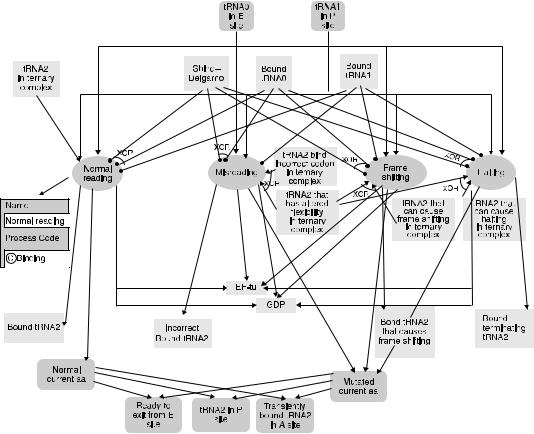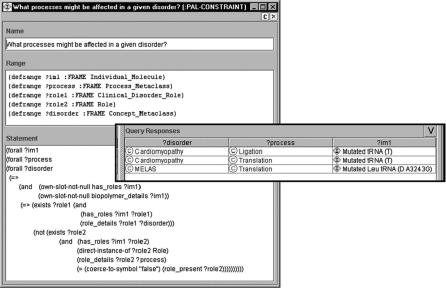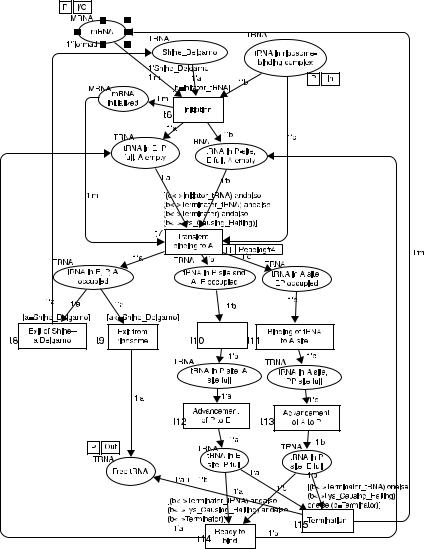
Genomics and Proteomics Engineering in Medicine and Biology - Metin Akay
.pdf
14
FIGURE 1.6. Process diagram showing normal and abnormal reading processes. Starting from a ribosome with tRNA in both E and P sites, four alternative processes can lead to ribosome with the A site occupied with tRNA: normal reading, misreading, frame shifting, and halting. Symbols are as explained in the legend of Figure 1.3. The insert shows the process code (binding) of the reading process, taken from the TAMBIS ontology.

1.3. MODELING APPROACH AND RESULTS |
15 |
1.3.5. Representing High-Level Clinical Phenotypes
Our clinical ontology relies on the UMLS but does not include all of the concepts of the Metathesaurus. Instead, we are building our clinical ontology by importing concepts as we need them. We add clinical concepts to the clinical ontology by creating them as subclasses of the semantic types defined by the semantic network. Each concept has a concept name and a concept code that come from the Metathesaurus as well as synonyms. Figure 1.7 shows part of the clinical ontology. Figure 1.3 shows that mutated leucine tRNA (in the tRNA acceptor domain) and mutated tRNA (in the T domain) have roles in some forms of cardiomyopathy. Many tRNA-related diseases are also linked to mutations in protein components of mitochondrial respiratory chains. Proteomic studies in [28] provide a larger list of protein candidates. Twenty identified proteins are shown to either overproduce (9) or be underrepresented (11) when the mitochondrial genome has the A8344G mutation (in tRNALys) associated with myoclonic epilepsy and ragged red fibers (MERFF) condition.
FIGURE 1.7. Query that shows individual molecules involved in both disorders and dysfunctional processes. The results of this query may indicate which processes are involved in a given disorder. The query is shown on the left. The results are shown on the right. The frames ?im1 ?process, ?role1, ?role2, and ?disorder represent individual molecules, processes, roles, and disorders, respectively. The query is written as a constraint. Instances that violate the constraint are returned. The predicate (own-slot-not-null A B) returns true if slot A of frame B is not null. The constraint looks for all individual molecules, which
(1) have roles that are disorders and (2) have roles that are dysfunctional processes or functions.

16 QUALITATIVE KNOWLEDGE MODELS IN FUNCTIONAL GENOMICS AND PROTEOMICS
1.3.6. Representing Levels of Evidence for Modeled Facts
Different facts that are represented in our framework are supported by varying degrees of evidence. It is important to allow users to know what support different facts have, especially in cases of conflicting information. We therefore added a categorization of evidence according to the type of experimentation by which facts were established. The categorization includes broad categories, such as “in vivo,” “in vitro,” “in situ,” “in culture,” “inferred from other species,” and “speculative.” Facts, such as the existence of a biomolecule or its involvement in a process are tagged with the evidence categories.
1.3.7. Querying the Model
Using PAL we composed first-order logic queries that represent in tabular form relationships among processes and structural components. Table 1.1 shows a
TABLE 1.1 Types of Biological Queries and Motivating Biological Examples
Query Type |
Example |
Derived Answer from Model |
|
|
|
|
|
1. |
Alleles |
|
|
1.1 |
Alleles that have |
Alleles that have roles in |
Mutated tRNA (T) causes cardi- |
roles in dysfunctional |
both dysfunctional pro- |
omyopathy and has roles in |
|
processes and/or |
cesses and disorders |
amino acylation þ halted |
|
disorders |
|
translation |
|
|
|
|
Mutated Leu tRNA (D) causes |
|
|
|
mitochondrial myopathy |
|
|
|
encephalopathy lactocidosis |
|
|
|
stroke (MELAS) and has a role |
|
|
|
in misreading |
2. |
Roles |
|
|
2.1 |
Individual molecules |
Individual molecules that |
Mutated tRNA (anticodon) and |
or biocomplexes that have |
have the same set of |
mutated tRNA (acceptor) both |
|
the same role |
roles |
have only the role of misreading |
|
Scoped to cellular |
Individual molecules that |
Incorrect translation: mutated |
|
location, same substrates |
have a role in a dys- |
tRNA (anticodon), mutated |
|
and products, same bio- |
functional process |
tRNA (T), mutated Pro tRNA |
|
logical process (partici- |
|
(anticodon U34mU), mutated |
|
pation), or to same (or |
|
Leu tRNA (D A3243G), mutated |
|
different) inhibitor |
|
tRNA (acceptor) |
|
|
|
|
Incorrect ligation: mutated |
|
|
|
tRNA (T) |
|
|
|
Incorrect processing: tRNA |
|
|
|
precursor with mutated 30 end |
|
|
Individual molecules that |
Cardiomyopathy: mutated tRNA |
|
|
have a role in a disorder |
(T), mutated Leu tRNA |
|
|
|
(acceptor) |
|
|
|
MELAS: mutated Leu tRNA (D) |
(continued)

|
|
1.3. MODELING APPROACH AND RESULTS |
17 |
|
TABLE 1.1 Continued |
|
|
|
|
|
|
|
||
Query Type |
Example |
Derived Answer from Model |
||
|
|
|
|
|
3. |
Reaction (functional model) |
|
|
|
3.1 |
All atomic |
What atomic activities |
None in the modeled system |
|
activities that share |
have the same sub- |
|
|
|
the same substrates |
strates and products? |
|
|
|
(products, inhibitors) |
|
|
|
|
4. Biological process
4.1All activities of a certain kind of biological process, according to the TAMBIS classification hierarchy (scoped to cellular location substrates)
4.2All activities that are inhibited by inhibitor x
4.3What processes might be affected in a given disorder?
All activities that are a kind of binding and involve binding of tRNA
Activities inhibited by tobramycin and mupirocin
What processes might be affected in a given disorder?
Formation of ternary complex, formation of initiation complex, formation of termination complex, binding to A site, normal reading, misreading, halting, frame shifting
Amino acid acylation
Amino acid acylation and translation (reading) are affected in cardiomyopathy
Translation (reading) is affected in cardiomyopathy
5.Reachability
5.1If an activity is inhibited what other activities can take place? Is it a deadlock?
5.2If an activity is inhibited, can we still get to a specified state?
5.3Does an inhibitor inhibit an entire high-level process?
5.4Establish a marking, find reachability
Inhibiting “normal reading” (no supply of normal tRNA): what activities may take place?
If we inhibit “formation of ternary complex,” can we reach a state where the activity “termination” is enabled?
Does tobramycin inhibit the translation process?
Elongating tRNA is a substrate. What pathways will be taken?
6.Temporal/dynamic aspects
6.1 What other |
What processes occur in |
processes occur in |
parallel to “binding to A |
parallel to process X? |
site” (Fig. 1.6) |
Directly in XOR: misreading, frame shifting, halting
Yes. For example, the firing sequence t1t2t4t1t2t5t6t7t8t10t11 t12t13 of Figure 1.8
Yes. It inhibits the process “formation of initiation complex” which is essential to take place before translation
Amino acid acylation, followed by formation of ternary complex, followed by translation
“Shine–Delgarno exits” XOR “tRNA1 exits”

18 QUALITATIVE KNOWLEDGE MODELS IN FUNCTIONAL GENOMICS AND PROTEOMICS
FIGURE 1.8. Colored Petri Net that corresponds to Figure 1.5 showing current three-site model of translation. Squares represent transitions, corresponding to workflow processes. Ellipses represent places, corresponding to conditions that are true after a workflow process has terminated. Text to the top left of places indicates their allowed token type, which can be tRNA or mRNA. The values of tokens of tRNA type used in this figure are Shine_ Delgarno, Initiator_tRNA, Terminator_tRNA, Terminator, and Lys_Causing_Halting. Other token types that we use in our model (not shown) represent other mutations of tRNA molecules. The values of tokens of mRNA type are always “normal.” Text below places specifies initial placement of tokens in those places. Text above transitions indicates guarding conditions, which refer to token types. Text on connectors indicates token variables that flow on those connectors. The variables used are a, b, and c for tRNA tokens and m for mRNA tokens. Transitions are also labeled t6, . . . , t15, in correspondence with query 5.2 of Table 1.1.
1.4. DISCUSSION |
19 |
summary of all the query types that we composed. They are grouped into six categories that concern (1) alleles, (2) functional roles and roles in disorder phenotypes, (3) reactions and their participants, (4) biological processes, (5) ability to reach a certain state of a modeled system, and (6) temporal/dynamic aspects of a modeled system. Queries that were especially interesting to us were (1) finding mutations that cause molecular-level processes and functions to be dysfunctional,
(2) finding mutations that cause clinical disorders, and (3) finding processes that might be affected in a given disorder. Figure 1.7 shows the query and query results for the third query.
1.3.8. Simulating the Model
As shown in Figures 1.4 and 1.5, we created two different models of the translation process: a historical model and a current model. When we translated the workflow models into the corresponding Petri Nets, we were able to test predictions of these two models by showing that under certain concentrations of reactants the different models resulted in different dynamic behavior which produced different translation products. For example, when the mRNA contained a sequence of Asn–Leu–Asn (or in general, aa1 –aa2 –aa1) and the system was initialized with a low concentration of Asn-tRNA, then protein translation proceeded in the classical two-site model but was halted in the current three-site model, which required Asn-tRNA and LeutRNA to be bound to the ribosome while a second Asn-tRNA bound the A site. The Petri Net that corresponds to the workflow model of Figure 1.5 is shown in Figure 1.8. The tRNA mutations were represented as colored tokens, belonging to the tRNA color set (see Fig. 1.8), and mRNA molecules were represented as tokens belonging to the mRNA color set.
The Petri nets derived from our workflow model can also be used for educational purposes. They can demonstrate (1) concurrent execution of low-level processes within the translation process (e.g., tRNA molecules that were incorporated into synthesized proteins can be amino acylated and used again in the translation process),
(2) introduction of mutations into synthesized proteins, and (3) the affect of certain dysfunctional components on pools of reactants (e.g., nonmutated tRNAs).
1.4. DISCUSSION
Deducing molecular mechanisms of disease based on molecular models is a very difficult problem. Even more complicated is the task of correlating genotypic variation to clinical phenotypes. A review by Florentz and Sissler [33] shows that, despite the accumulation of information about the positions of a large number of mutations within mitochondrial tRNAs, it is not possible to identify simple basic patterns for use in predicting the pathogenicity of new mutations. The multifaceted nature of effects produced by tRNA mutations is apparent from recent proteomics studies [29] and is emphasized in current reviews [34, 35]. The authors conclude that it is critical to examine not only the affected tRNA but also its interactions, or relationships, with other compartmental components. These arguments
20 QUALITATIVE KNOWLEDGE MODELS IN FUNCTIONAL GENOMICS AND PROTEOMICS
emphasize the importance of a knowledge model able to integrate practical information at multiple levels of detail and from multiple experimental sources.
The knowledge framework presented here links genetic sequence, structure, and local behavior to high-level biological processes (such as disease). The model provides a mechanism for integrating data from multiple sources. In our tRNA example, we integrated information from structural biology, genetics and genomics, molecular biology, proteomics, and clinical science. The information can be presented graphically as process diagrams or participant/role diagrams. The frames that represent participants, roles, processes, and relationships among them contain citations to the original data sources.
Our model has several advantages, in addition to its ability to integrate data from different sources. First, we can define queries that create views of the model in a tabular format. The queries extract useful relationships among structures, sequences, roles, processes, and clinical phenotypes. Second, our model can be mapped in a straightforward manner to Petri Nets. We developed software that automatically translates our biological process model into Petri Net formalisms and formats used by various Petri Net tools [36]. We have used available tools to qualitatively simulate a modeled system and to verify its boundedness and liveness and to answer a set of biological questions that we defined [36]. Boundedness assumes that there is no infinite accumulation of tokens in any system state. In our example, this corresponds to concentration of tRNA and mRNA molecules in a cell. Liveness ensures that all Petri Net transitions (which correspond to workflow activities) can be traversed (enabled).
A disadvantage of our model is its need for manual data entry. Natural language processing techniques are not able to automatically parse scientific papers into the semantic structure of our ontology. The effort required to enter data into our model is considerable. The entry of a substantial set of data about all relevant cellular reactions and processes would require a major distributed effort by investigators trained in knowledge representation and biology.
1.5. CONCLUSION
One of the ultimate goals of proteomics and genomics engineering is to develop a model of the real cell, of its program responsible for different behaviors in various intraand extracellular environments. Our long-term goal is to develop a robust knowledge framework that is detailed enough to represent the phenotypic effects of genomic mutations. The results presented here are a first step in which we demonstrate that the knowledge model developed in another context (malaria invasion biology) is capable of capturing a qualitative model of tRNA function. We have presented a graphical knowledge model for linking genetic sequence polymorphisms to their structural, functional, and dynamic/behavioral consequences, including disease phenotypes. We have shown that the resulting qualitative model can be queried (1) to represent the compositional properties of the molecular ensembles, (2) to represent the ways in which abnormal processes can result from
REFERENCES 21
structural variants, and (3) to represent the molecular details associated with highlevel physiological and clinical phenomena. By translating the workflow representation into Petri Nets we were able to verify boundedness and liveness. Using simulation tools, we showed that the Petri Nets derived from the historic and current views of the translation process yield different dynamic behavior.
ACKNOWLEDGMENTS
The work was funded by the Burroughs-Wellcome Fund and by National Institutes of Health grants LM-05652 and LM-06422.
REFERENCES
1.M. Peleg, I. Yeh, and R. B. Altman, “Modeling biological processes using Workflow and Petri Net models,” Bioinformatics, 18: 825–837, 2002.
2.T. R. Gruber, “Toward principles for the design of ontologies used for knowledge sharing,” Int. J. Human-Computer Stud., 43: 907–928, 1995.
3.S. Schulze-Kremer, “Ontologies for molecular biology,” paper presented at the Proceedings of the Third Pacific Symposium on Biocomputing, Hawaii, 1998.
4.M. Ibba, C. Stathopoulos, and D. Soll, “Protein synthesis: Twenty three amino acids and counting,” Curr Biol., 11: R563–565, 2001.
5.K. H. Nierahus, “New aspects of the ribosomal elongation cycle,” Mol. Cell Biochem., 61: 63–81, 1984.
6.D. N. Wilson, G. Blaha, S. R. Conell, P. V. Ivanov, H. Jenke, U. Stelzl, Y. Teraoka, and K. H. Nierahus, “Protein synthesis at atomic resolution: Mechanistics of translation in the light of highly resolved structures for the ribosome,” Curr. Protein Peptide Sci., 3: 1–53, 2002.
7.P. J. Farabaugh and G. R. Bjork, “How translational accuracy influences reading frame maintenance,” EMBO J., 18: 1427–1434, 1999.
8.V. Volpetti, R. Gallerani, C. D. Benedetto, S. Liuni, F. Licciulli, and L. R. Ceci, “PLMltRNA, a database on the heterogenous genetic origin of mitochondrial tRNa genes and tRNAs in photosynthetic eukaryotes,” Nucleic Acids Res., 31: 436–438, 2003.
9.M. Peleg, I. S. Gabashvili, and R. B. Altman, “Qualitative models of molecular function: Linking genetic polymorphisms of tRNA to their functional sequelae,” Proc. IEEE, 90: 1875–1886, 2002.
10.L. Fisher, Workflow Handbook, published in association with the Workflow Management Coalition, Future Strategies, Lighthouse Point, FL, 2001.
11.J. L. Peterson, Petri Net Theory and the Modeling of Systems, Prentice-Hall, Englewood Cliffs, NJ, 1981.
12. W. M. P. v. d. Aalst, “The application of Petri Nets to workflow management,”
J. Circuits, Syst. Computers, 8: 21–66, 1998.
13.P. G. Baker, C. A. Goble, S. Bechhofer, N. W. Paton, R. Stevens, and A. Brass, “An ontology for bioinformatics applications,” Bioinformatics, 15: 510–520, 1999.
14.C. Lindberg, “The Unified Medical Language System (UMLS) of the National Library of Medicine,” J. Am. Med. Rec. Assoc., 61: 40–42, 1990.
22QUALITATIVE KNOWLEDGE MODELS IN FUNCTIONAL GENOMICS AND PROTEOMICS
15.J. Odell, “Six different kinds of composition,” J. Object-Oriented Prog., 7: 10–15, 1994.
16.S. W. Tu and M. A. Musen, “Modeling data and knowledge in the EON guideline architecture,” paper presented at Medinfo, London, 2001.
17.H. M. W. Verbeek, T. Basten, and W. M. P. v. d. Aalst, “Diagnosing workflow processes using Woflan,” Computer J., 44: 246–279, 2001.
18.D. CPN group at the University of Aarhus, “Design/CPN—Computer Tool for Coloured Petri Nets,” http://www.daimi.au.dk/designCPN/, 2002.
19.M. Helm, H. Brule, D. Friede, R. Giege, D. Putz, and C. Florentz, “Search for characteristic structural features of mammalian mitochondrial tRNAs,” RNA, 6: 1356–1379, 2000.
20.M. Sprinzl and K. S.Vassilenko, “Compilation of tRNA sequences and sequences of tRNA genes,” Nucleic Acids Res., 33: D135–D138, 2005.
21.J. Cannone, S. Subramanian, M. N. Schnare, J. R. Collett, L. M. D’Souza, Y. Du, B. Feng,
N.Lin, L. V. Madabusi, K. M. Muller, N. Pande, Z. Shang, N. Yu, and R. R. Gutell, “The Comparative RNA Web (CRW) site: An online database of comparative sequence and structure information for ribosomal, intron, and other RNAs,” BMC Bioinformatics, 3: 2, 2002.
22.P. S. Klosterman, M. Tamura, S. R. Holbrook, and S. E. Brenner, “SCOR: A structural classification of RNA database,” Nucleic Acids Res., 30: 392–394, 2002.
23.P. A. Limbach, P. F. Crain, and J. A. McCloskey, “Summary: The modified nucleosides of RNA,” Nucleic Acids Res., 22: 2183–2196, 1994.
24.“Online Mendelian Inheritance in Man, OMIM (TM),” McKusick-Nathans Institute for Genetic Medicine, Johns Hopkins University (Baltimore, MD) and National Center for Biotechnology Information, National Library of Medicine (Bethesda, MD), http:// www.ncbi.nlm.nih.gov/omim/, 2000.
25.P. D. Karp, C. A. Ouzounis, C. Moore-Kochlacs, L. Goldovsky, P. Kaipa, D. Ahre´n,
S.Tsoka, N. Darzentas, V. Kunin, and N. Lo´pez-Bigas, “Expansion of the BioCyc collection of pathway/genome databases to 160 genomes,” Nucleic Acids Res., 33: 6083–6089, 2005.
26.D. L. Wheeler, T. Barrett, D. A. Benson., S. H. Bryant, K. Canese, D. M. Church,
M.DiCuccio, R. Edgar, S. Federhen, W. Helmberg, D. L. Kenton, O. Khovayko, D. J. Lipman, T. L. Madden, D. R. Maglott, J. Ostell, J. U. Pontius, K. D. Pruitt, G. D. Schuler, L. M. Schrim, E. Sequeira, S. T. Sherry, K. Sirotkin, G. Starchenko, T. O. Suzek, R. Tatusov, T. A. Tatusova, L. Wagner, and E. Yaschenko, “Database resources of the National Center for Biotechnology Information,” Nucleic Acids Res., 33: D39– D45, 2005.
27.M. C. Brandon, M. T., Lott, K. C. Nguyen, S. Spolim, S. B. Navathe, P. Baldi, and D. C. Wallace, “MITOMAP: A human mitochondrial genome database—2004 update,” Nucleic Acids Res., 33: D611–613, 2005.
28.W. T. Peng, M. D. Robinson, S. Mnaimneh, N. J. Krogan, G. Cagney, Q. Morris, A. P. Davierwala, J. Grigull, X. Yang, W. Zhang, N. Mitsakakis, O. W. Ryan, N. Datta,
V.Jojic, C. Pal, V. Canadien, D. Richards, B. Beattie, L. F. Wu, S. J. Altschuler,
S.Roweis, B. J. Frey, A. Emili, J. F. Greenblatt, and T. R. Hughes, “A panoramic view of yeast noncoding RNA processing,” Cell, 113: 919–933, 2003.
29.P. Tryoen-Toth, S. Richert, B. Sohm, M. Mine, C. Marsac, A. V. Dorsselaer, E. Leize, and
C.Florentz, “Proteomic consequences of a human mitochondrial tRNA mutation beyond the frame of mitochondrial translation,” J. Biol. Chem., 278: 24314–24323, 2003.
REFERENCES 23
30.V. Giudicelli and M. P. Lefranc, “Ontology for immunogenetics: The IMGTONTOLOGY,” Bioinformatics, 15: 1047–1054, 1099.
31.D. Dori, “Object-process analysis: Maintaining the balance between system structure and behavior,” J. Logic Computation, 5: 227–249, 1995.
32.S. Connell and K. Nierahus, “Translational termination not yet at its end,” Chembiochem, 1: 250–253, 2000.
33.C. Florentz and M. Sissler, “Disease-related versus polymorphic mutations in human mitochondrial tRNAs: Where is the difference?,” EMBO Reps., 2: 481–486, 2001.
34.H. T. Jacobs, “Disorders of mitochondrial protein synthesis,” Hum. Mol. Genet., 12: R293–R301, 2003.
35.L. M. Wittenhagen and S. O. Kelley, “Impact of disease-related mitochondrial mutations on tRNA structure and function,” Trends Biochem. Sci., 28: 605–611, 2003.
36.M. Peleg, D. Rubin, and R. B. Altman, “Using Petri Net tools to study properties and dynamics of biological systems,” J. Am. Med. Inform. Assoc., 12(2): 181–199, 2005.
